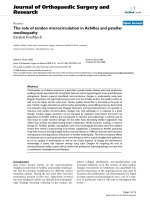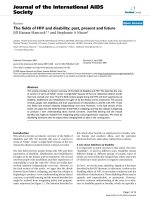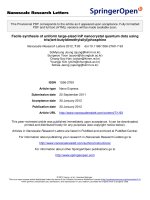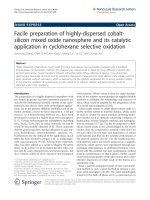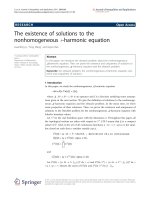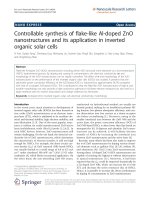Báo cáo hóa học: " Facile synthesis of nano-Li4Ti5O12 for high-rate Li ion battery anodes" doc
Bạn đang xem bản rút gọn của tài liệu. Xem và tải ngay bản đầy đủ của tài liệu tại đây (1.63 MB, 13 trang )
Nanoscale Research Letters
This Provisional PDF corresponds to the article as it appeared upon acceptance. Fully formatted
PDF and full text (HTML) versions will be made available soon.
Facile synthesis of nano-Li4Ti5O12 for high-rate Li ion battery anodes
Nanoscale Research Letters 2012, 7:10
doi:10.1186/1556-276X-7-10
Yun-Ho Jin ()
Kyung-Mi Min ()
Hyun-Woo Shim ()
Seung-Deok Seo ()
In-Sung Hwang ()
Kyung-Soo Park ()
Dong-Wan Kim ()
ISSN
Article type
1556-276X
Nano Express
Submission date
2 September 2011
Acceptance date
5 January 2012
Publication date
5 January 2012
Article URL
/>
This peer-reviewed article was published immediately upon acceptance. It can be downloaded,
printed and distributed freely for any purposes (see copyright notice below).
Articles in Nanoscale Research Letters are listed in PubMed and archived at PubMed Central.
For information about publishing your research in Nanoscale Research Letters go to
/>For information about other SpringerOpen publications go to
© 2012 Jin et al. ; licensee Springer.
This is an open access article distributed under the terms of the Creative Commons Attribution License ( />which permits unrestricted use, distribution, and reproduction in any medium, provided the original work is properly cited.
Facile synthesis of nano-Li4Ti5O12 for high-rate Li-ion battery anodes
Yun-Ho Jin1, Kyung-Mi Min1, Hyun-Woo Shim1, Seung-Deok Seo1, In-Sung Hwang1,
Kyung-Soo Park1, and Dong-Wan Kim*1
1
Department of Materials Science and Engineering, Ajou University, Suwon 443-749,
South Korea
*Corresponding author:
Email addresses:
Y-HJ:
K-MM:
H-WS:
S-DS:
I-SH:
K-SP:
D-WK:
Abstract
One of the most promising anode materials for Li-ion batteries, Li4Ti5O12, has
attracted attention because it is a zero-strain Li insertion host having a stable insertion
potential. In this study, we suggest two different synthetic processes to prepare
Li4Ti5O12 using anatase TiO2 nanoprecursors. TiO2 powders, which have
extraordinarily large surface areas of more than 250 m2 g−1, were initially prepared
through the urea-forced hydrolysis/precipitation route below 100°C. For the synthesis
of Li4Ti5O12, LiOH and Li2CO3 were added to TiO2 solutions prepared in water and
ethanol media, respectively. The powders were subsequently dried and calcined at
various temperatures. The phase and morphological transitions from TiO2 to Li4Ti5O12
were characterized using X-ray powder diffraction and transmission electron
microscopy. The electrochemical performance of nanosized Li4Ti5O12 was evaluated
in detail by cyclic voltammetry and galvanostatic cycling. Furthermore, the high-rate
performance and long-term cycle stability of Li4Ti5O12 anodes for use in Li-ion
batteries were discussed.
Introduction
Li4Ti5O12 is one of the most promising anode materials for Li-ion batteries even
though it has lower specific capacity (175 mAh g−1) than does graphite (372 mAh g−1).
One of the unique properties of Li4Ti5O12 is the negligible lattice change in the Li-ion
insertion/desertion process, which provides good high-rate cycling stability [1]. The
electrochemical properties of Li4Ti5O12 are dependent on its method of preparation.
The conventional solid-state, sol-gel [2], hydrothermal [3], spray pyrolysis [4], and
combustion [5] methods have been proposed for Li4Ti5O12 synthesis. Among these,
1
the solid-state process is a simple method that is well suited for production scale-up.
However, the solid-state process using TiO2 as a starting precursor requires lengthy
heating with Li salts at high temperatures in order to obtain highly crystalline
Li4Ti5O12 [6]. As a result, particle size control is more difficult than that in
hydrothermal or sol-gel method, and the resultant larger particles lead to poor capacity
retention and rate capability.
Herein, we demonstrate the preparation of highly crystalline nanosized
Li4Ti5O12 [nano-Li4Ti5O12] with a uniform particle size via a urea-mediated wet
process, in which a TiO2 precursor with a large surface area is initially formed,
followed by wet and solid-state processes with different Li sources, LiOH and Li2CO3,
respectively. After subsequent heat treatment, the electrochemical performance of the
resultant Li4Ti5O12 as an anode for Li-ion batteries is evaluated and discussed.
Experimental procedure
Preparation of TiO2 precursor
TiO2 nanoparticles with an anatase structure were prepared using the ureamediated precipitation method [7], in which 0.015 M titanium trichloride (20% in 3%
hydrochloric acid, TiCl3, Alfa Aesar, Ward Hill, MA, USA) and 3.0 M urea (99.3%,
(NH2)2CO, Alfa Aesar, Ward Hill, MA, USA) were dissolved in deionized [DI] water
at room temperature. The solution was heated at 90°C to 100°C for 4 h with magnetic
stirring. Precipitates were obtained by centrifugation and repeated washing (five times
with DI water and once with anhydrous ethanol). The powders were dried at 100°C
for several hours in a vacuum oven.
Preparation of Li4Ti5O12
Wet process
Stoichiometric amounts of the prepared TiO2 nanopowder were dispersed in
DI water by sonication for 2 h. A stoichiometric amount of LiOH (98%, SigmaAldrich, St. Louis, MO, USA) was then dissolved in the solution with stirring. The
resulting white-colored suspensions were heated at 110°C to evaporate water. Finally,
the powder was calcined at various temperatures in air to afford Li4Ti5O12.
Solid-state process
For the solid-state process, Li2CO3 (99%, Sigma-Aldrich, St. Louis, MO,
USA) was chosen as the Li source. The stoichiometric mixture was agitated for 24 h
with a zirconia ball in absolute ethanol, dried, and calcined at various temperatures in
air.
Characterization of TiO2 precursors and Li4Ti5O12 nanoparticles
The powders were characterized by X-ray powder diffraction [XRD] (D/max2500V, Rigaku, Tokyo, Japan), Brunauer-Emmett-Teller [BET] (Belsorp-mini II, BEL
2
Japan Inc., Osaka, Japan) surface area determination, high-resolution transmission
electron microscopy [HRTEM] (JEM-3000F, JEOL, Tokyo, Japan) at an accelerating
voltage of 300 kV, and field-emission scanning electron microscopy [FESEM] (JSM6700F, JEOL, Tokyo, Japan).
Electrochemical analysis
A mixture consisting of 70 wt.% of the active materials, 15 wt.% Super P
carbon black (MMM Carbon, Brussels, Belgium), and 15 wt.% Kynar 2801 binder
(PVDF-HFP, Arkema Inc., King of Prussia, PA, USA) was dissolved in 1-methyl-2pyrrolidinone (Sigma-Aldrich, St. Louis, MO, USA) solvent for uniform dispersion of
the active materials on a Cu foil to obtain positive electrodes. Then, the solvent was
evaporated in a vacuum oven at 100°C. A Swagelok-type cell was assembled in an Arfilled glove box in order to protect the cell from oxidation and moisture. A Li metal
foil (negative electrode) and the prepared mixture (positive electrode) were saturated
with a liquid electrolyte obtained by dissolving 1 M LiPF6 in ethylene carbonate and
dimethyl carbonate (1:1 by volume, Techno Semichem Co., Ltd., Sungnam, South
Korea). Li4Ti5O12 powders were analyzed by the galvanostatic discharge/charge
cycling method and cyclic voltammetry [CV] measurements with a battery cycler
(WBCS 3000, WonATech, Seoul, South Korea). Each cell was cycled through a
voltage range of 1.0 to 2.5 V versus Li/Li+.
Results and discussion
The XRD pattern (Figure 1a) for precursor powders indicated that they
comprised anatase-phase TiO2 (Joint Committee of Powder Diffraction System
[JCPDS] #21-1272). The TiO2 morphology was found to be flower-like clusters of 50
nm in size, which comprised tiny aggregated nanorods (Figure 1b). For this reason,
the powder had an extremely large surface area, 267 m2 g−1, as confirmed by BET
surface area measurements. In addition, the electron diffraction (selected area electron
diffraction [SAED]) pattern of the selected area coincided with that of anatase TiO2,
as shown in the inset of Figure 1b.
In order to obtain nano-Li4Ti5O12 with a sufficiently large surface area, the
TiO2 powders prepared as mentioned above were used as precursors. After mixing the
TiO2 precursor with LiOH and Li2CO3 through wet and solid-state processes,
respectively, both mixtures were calcined at 700°C and 800°C and were found to
mainly comprise the cubic Li4Ti5O12 phase (JCPDS #49-0207; Figure 2). However,
the Li4Ti5O12 powders prepared through the wet process had an undesirable (Liinactive) secondary phase, Li2TiO3 (JCPDS #33-0831), even after calcination at
800°C as confirmed by the XRD peak at 2θ = 35.6°. As opposed to the powders
prepared by the wet process, those prepared through the solid-state process showed an
almost pure Li4Ti5O12 phase with negligible secondary phases.
Figures 3a,b show the typical FESEM and HRTEM images of the Li4Ti5O12
powders prepared through the solid-state process. Small and uniformly sized
3
Li4Ti5O12 particles (50 to 100 nm) were obtained even if the calcination temperature
was 700°C, which could be attributed to the unique TiO2 nanoprecursors with
extremely large surface areas. These Li4Ti5O12 powders were further investigated by
HRTEM, as shown in Figure 3c. The typical HRTEM image was recorded from a
single particle with lattice fringes of approximately 0.496 nm, which corresponded to
the (111) interplanar spacing in Li4Ti5O12. The presence of single-phase Li4Ti5O12 was
also confirmed from the SAED patterns shown in the inset of Figure 3c.
Nanostructured electrode materials help in enhancing the performance of Liion batteries by providing higher electrode/electrolyte contact areas, shorter Li+
diffusion lengths (L) in the intercalation host (smaller time constant (τ); τ = L2/2D,
where D is the coupled diffusion coefficient for Li+ and e−), and better
accommodation of the Li-ion insertion/extraction strain [8, 9]. Figure 4 shows the
electrochemical activity of nano-Li4Ti5O12 powders that were prepared through the
solid-state process. These CV measurements were carried out during the initial five
cycles using a half cell with Li metal foil as the negative electrode, operating at 0.3
mV/s. Clear cathodic and anodic peaks appeared at approximately 1.46 and 1.7 V,
respectively, for the Li intercalation/deintercalation, in accordance with the pair of
peaks reported for Li4Ti5O12 powders [10]. The following electrochemical reaction of
Li4Ti5O12 with Li has been suggested [11]:
Li 4 Ti 5O12 + 3 Li + + 3 e− ↔ Li 7 Ti5 O12 .
Figure 4b shows the galvanostatic cycling characteristics of nano-Li4Ti5O12
powders that were prepared through the solid-state process. The first discharge
capacity was 154 mAh g−1 over a voltage window of 1.0 to 2.5 V at a current rate of 1
C (175 mAh g−1; here, C is defined as three Li ions per hour and per formula unit of
Li4Ti5O12 on the basis of the above equation). The reversible capacities were observed
to be 135, 133, 131, 130, and 128 mAh g−1 after 100, 200, 300, 400, and 500 cycles,
respectively. Indeed, it is interesting to note that the nano-Li4Ti5O12 electrode in this
study shows superior long-term cyclability and negligible variation in reversible
capacity upon cycling (0.013% fading per cycle between 100 and 500 cycles).
Figure 5 shows the rate capability of the nano-Li4Ti5O12 powders that were
prepared through the solid-state process, for up to 20 C. The cells were charged and
discharged at 1 C for the first 10 cycles, and then, the rate was increased in stages to
20 C. At a rate of 20 C, the capacity of the nano-Li4Ti5O12 powders was still high: 112
mAh g−1. This outstanding performance at high rates was much better than that
afforded by any of the various types of Li4Ti5O12 nanostructures such as nanowires
and nanoparticles [3, 12, 13]. In particular, the nano-Li4Ti5O12 powders calcined at
700°C exhibited better long-term cyclability as well as superior rate capabilities than
those calcined at 800°C (Figure 5), possibly a result of the nanosize effect of the small
particle size and large surface area.
Conclusion
In summary, spinel-type nano-Li4Ti5O12 particles were synthesized by a solid4
state process from a large-surface-area TiO2 precursor and subsequent calcination at
700°C. The average particle size of these nano-Li4Ti5O12 particles was 50 to 100 nm.
High Li electroactivity was confirmed by CV experiments. The nano-Li4Ti5O12
particles calcined at 700°C showed a high Li storage capacity of 128 mAh g−1 after
500 cycles at 1 C and superior cycle performance (112 mAh g−1) even at a high rate of
20 C. The enhanced reversible capacity and cycling performance were attributed to
the formation of highly crystalline, uniform nanoparticles, which make this nanoLi4Ti5O12 a potential host material for high-powder Li-ion batteries.
Competing interests
The authors declare that they have no competing interests.
Authors' contributions
Y-HJ carried out the TiO2 and Li4Ti5O12 sample preparation and drafted the
manuscript. K-MM and H-WS fulfilled the electrochemical analyses. S-DS, I-SH, and
K-SP participated in the microstructural analysis. D-WK designed the study, led the
discussion of the results, and participated in writing the manuscript. All authors read
and approved the final manuscript.
Acknowledgments
This work was supported by the National Research Foundation of Korea (NRF) grant
funded by the Korean government (MEST; No. 2010-0029617 & 2011-0005776) and
was completed with Ajou University Research Fellowship of 2011 (S-2011-G000100070).
References
1. Jiang C, Ichihara M, Honma I, Zhou H: Effect of particle dispersion on high rate
performance of nano-sized Li4Ti5O12 anode. Electrochimica Acta 2007, 52:6470.
2. Kavana L, Grätzel M: Facile synthesis of nanocrystalline Li4Ti5O12 (spinel)
exhibiting fast Li insertion. Electrochem Solid-State Lett 2002, 5:A39.
3. Li J, Tang J, Zhang Z: Controllable formation and electrochemical properties of
one-dimensional nanostructured spinel Li4Ti5O12. Electrochem Commun 2005,
7:894.
4. Ju SH, Kang YC: Characteristics of spherical-shaped Li4Ti5O12 anode powders
prepared by spray pyrolysis. J Phys Chem Solids 2009, 70:40.
5
5. Yuan T, Cai R, Wang K, Ran R, Liu S, Shao Z: Combustion synthesis of highperformance Li4Ti5O12 for secondary Li-ion battery. Ceram Int 2009, 35:1757.
6. Ferg E, Gummow RJ, de Kock A, Thackeray MM: Spinel anodes for lithium-ion
batteries. J Electrochem Soc 1994, 141:L147.
7. Jin YH, Lee SH, Shim HW, Ko KH, Kim DW: Tailoring high-surface-area
nanocrystalline TiO2 polymorphs for high-power Li ion battery electrodes.
Electrochimica Acta 2010, 55:7315.
8. Kunduraci M, Amatucci GG: The effect of particle size and morphology on the
rate capability of 4.7 V LiMn1.5+δNi0.5−δO4 spinel lithium-ion battery cathodes.
−
Electrochimica Acta 2008, 53:4193.
9. Ren Y, Armstrong AR, Jiao F, Bruce PG: Influence of size on the rate of
mesoporous electrodes for lithium batteries. J Am Chem Soc 2010, 132:996.
10. Woo SW, Dokko K, Kanamura K: Preparation and characterization of three
dimensionally ordered macroporous Li4Ti5O12 anode for lithium batteries.
Electrochimica Acta 2007, 53:79.
11. Ohsuku T, Ueda A, Yamamoto N: Zero-strain insertion material of
Li[Li1/3Ti5/3]O4 for rechargeable lithium cells. J Electrochem Soc 1995, 142:1431.
12. Lee DK, Shim HW, An JS, Cho CM, Cho IS, Hong KS, Kim DW: Synthesis of
heterogeneous Li4Ti5O12 nanostructured anodes with long-term cycle stability.
Nanoscale Res Lett 2010, 5:1585.
13. Lee SS, Byun KT, Park JP, Kim SK, Kwak HY, Shim IW: Preparation of
Li4Ti5O12 nanoparticles by a simple sonochemical method. Dalton Trans 2007,
37:4182.
Figure 1. Characterization of TiO2 products. (a) A typical XRD pattern. (b) A TEM
image of TiO2 precursor powders. The inset in (b) shows SAED patterns. (By Jin YH
et al.)
Figure 2. XRD patterns of Li4Ti5O12 powders. Li4Ti5O12 prepared through wet and
solid-state processes and subsequently calcined at 700°C and 800°C for 4 h. (By Jin
YH et al.)
Figure 3. FESEM and HRTEM images. (a) FESEM images of a typical Li4Ti5O12.
(b) Low-magnification HRTEM images of Li4Ti5O12. (c) HRTEM images of Li4Ti5O12
powders prepared through the solid-state process and subsequently calcined at 700°C
for 4 h. The inset in (c) shows SAED patterns. (By Jin YH et al.)
Figure 4. Electrochemical performance of Li4Ti5O12. (a) A cyclic voltammogram
of Li4Ti5O12. (b) Charge-discharge profiles of Li4Ti5O12 powders prepared through the
solid-state process and subsequently calcined at 700°C for 4 h. (By Jin YH et al.)
6
Figure 5. Rate capability of Li4Ti5O12. Cycling behavior at different C values for
Li4Ti5O12 powders prepared through the solid-state process and subsequently calcined
at 700°C and 800°C for 4 h. Solid and open circles indicate discharge and charge
capacities, respectively. (By Jin YH et al.)
7
Figure 1
Figure 2
Figure 4
Figure 5

